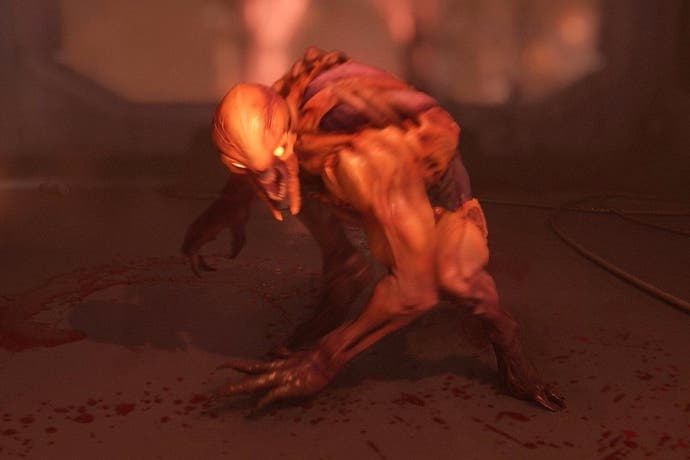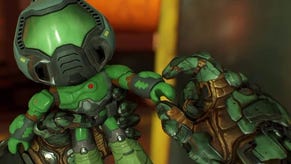The Doom campaign is actually pretty good
Thoughts on the wonky but hectic and surprisingly subtle story mode.
Since we've only just received Doom review code, we're going to have a full review up next week. In the meantime, here are some early impressions of the campaign.
Remember the original Doom's pistol? It's the crappy little pea-shooter you fall back on when you've no other option, the spindly popgun you switch to when you're saving the beefier weapons for more deserving prey. Well, nowadays they call the pistol "the Standard UAC Energy-Matter-Gel Sidearm", and it is a product of Serious Science. See, there's a "gravity gear dynamo" in the stock which "charges a capacitor" as the "operator" (that's you) moves around. When you pull the trigger, the capacitor "compresses up to four megawatts of Argent Energy into a hardened plasma gel and launches the slug at high velocity".
Said gel slug "has the same impact properties of conventional ammunition, making the weapon act and feel like a standard ballistic firearm". Just like a pistol, then, but smarter. But hold on a moment there, Professor. In keeping with Newton, won't compressing that quantity of energy so quickly lead to overheating? My dear fellow, far from it. The Standard UAC Energy-Matter-Gel Sidearm "is constructed of thermally diffusive metal alloys which allow it to discharge rapidly and repeatedly". Walk with me, if you will, while I expound upon the particulars. Or, you could just shoot a few demons in the head with it. Up to you.
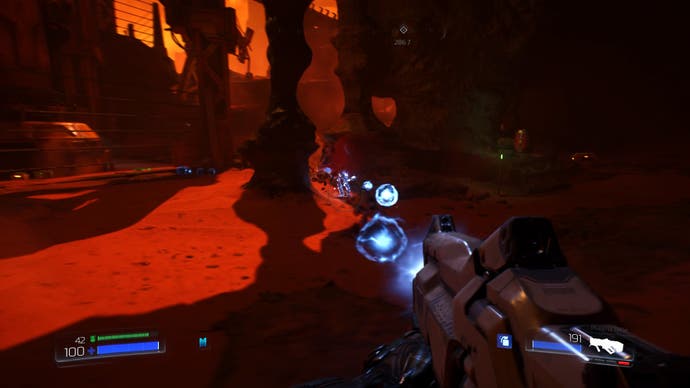
As you've hopefully guessed, the new Doom is a game with its heart in two places. On the one hand, it aims to restore something of the original Doom's gorgeously treacherous level design and darting combat flow. On the other, it wants to tick all the boxes associated with a modern story-heavy shooter campaign in the Bioshock vein - holographic echoes of now-butchered people fiddling around with ancient artefacts, upgradeable gear, weapon select wheels and a lore database intent on sapping all enthusiasm for the gorgeous weapons by explaining them to death. Consider the Heavy Assault Rifle, which "although recently superseded by the Plasma Rifle as the UAC's standard issue weapon, is still in widespread use due to its dependable mechanical firing mechanism". Do try to bear that in mind next time you shred a Cacodemon with the thing.
The good news is that on the strength of a few hours' play - and providing you turn a blind eye to any pop-up codex notifications - the Doom of 2016 feels like it might actually reconcile these approaches without bursting into flames. Id has evidently thought very hard, if not always sensibly, about where latter-day design trends do and don't agree with Doom's DNA. Case in point, the "intro". Going by the lumps of backstory on the loading screen, I was half-expecting a cosy video call from Wifey back on Earth and some sort of new employee orientation sequence. What actually happens is that you wake up on an operating table, rip away your restraints and pulp a zombie's head with your bare hands, all inside of about 10 seconds. It turns out this is exactly as much orientation as you need in a game about murdering demons on Mars.
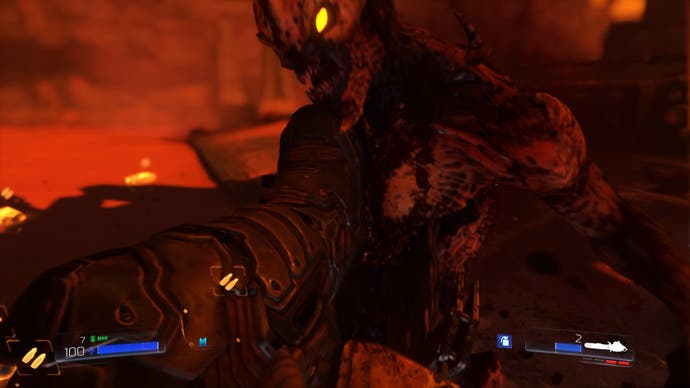
Perhaps the most unjust thing you can say of the original Doom is that it's a shooter. Sure, there are rocket launchers and they make Hell Barons go splat pretty good, but the guns aren't really the point. The core components of the 1993 game's appeal are its maps, or rather, dungeons - shifting Stygian warrens of flesh and bulkhead, in which no chamber is without its fair share of false walls, trick floors, mysterious switches, teleportation pads and tantalisingly out-of-reach power-ups.
The 2016 version clearly gets this, though it has yet to really surprise me. While compact by current genre standards, the first few campaign maps are agreeably knotty, with all sorts of secrets visible on walkways or dropped invitingly behind malfunctioning doors. Probe these nooks and crannies and you'll earn upgrade points for your guns - each weapon offers a choice of alternate fires, such as the shotgun's hold-to-charge grenade launcher. More importantly, you'll come away with the sense that the environments are there to savour, rather than conquer. There aren't nearly enough moving parts for my tastes, and the campaign seems over-reliant on arena battles where the inevitable base AI imposes a lockdown till you've slaughtered all the wildlife. But it's a promising start - and if there are too many arenas, I can't knock how how id Software has overhauled the combat itself.
Doom's Marine has always been a nimble beast, zipping past corridor mouths to spew missiles at distant, malignant pixels, but in the past he was limited to the horizontal plane. Nowadays you can jump and climb, and the arena sections are built around this capacity for acrobatics, with loads of crates, pipes and platforms to slide onto and bounce between as you flee the wrath of the underworld.
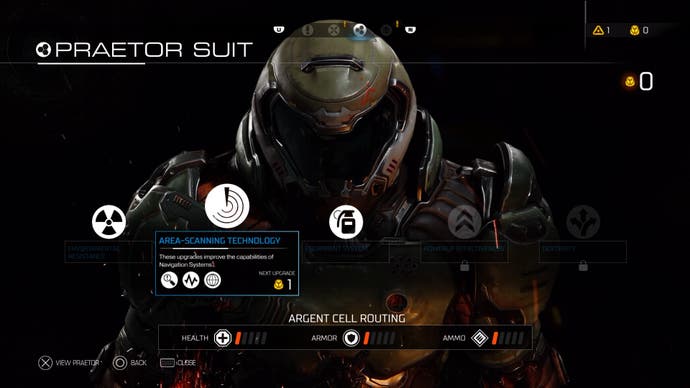
The demons have more spring in their step, too. In particular, I adore the newly hyperactive Imp - no longer a sort of clay sausage-man tossing fireballs from an alcove, but a vicious little insect that's forever scrambling up walls or wriggling under shotgun blasts to swipe at your guts. Another early standout is the possessed sentry, a former human elite who rocks a handheld energy shield and shotgun - distressing indeed when you're backed into a corner. In general, there's a nice sense of layering to the encounter design, with bog-standard zombies who shamble towards you slowly but steadily while you're preoccupied with more eye-catching threats.
The game's "Glory Kills" melee execution system has attracted the ire of purists - this lets you polish off a weakened, flashing foe in spectacular style with a single button press, showering you in Stimpacks to boot. It certainly sounds like a banal cosmetic flourish, but actually serves a function similar to Bloodborne's rallying, whereby you'll often need to risk close quarters combat if you want to heal up. There's a similar touch of risk-and-reward to managing ammo reserves - you can masticate opponents with a chainsaw to refill your weapons, which again entails putting yourself in harm's way. I'm hoping later levels will really force me to dig into these systems, in addition to each weapon's alternate fire and the environment.
The trick to rebooting a great video game series is to rediscover its context. Bringing back specific mechanics or systems is pointless in itself, like applying lipstick and blusher to rotten flesh; instead, designers must treat on the old title in broader terms, looking at what made it special for the era and seeking to replicate those emotions, that sensibility, with today's tools and in today's climate. I'm not sure the new Doom has managed this - any shooter that turns a pistol into a potted academic treatise is missing a few screws - but it's definitely trying. It's not just Doom-as-was with refreshed visuals, or a slick, generic, modern-age contender with some throwback cannons. And for that, I'm going to take a risk ahead of our full review and say it might be worth your time. Be sure to steer clear of those codex notifications.
